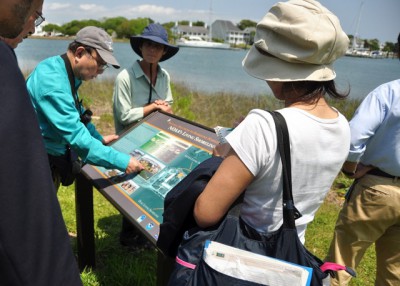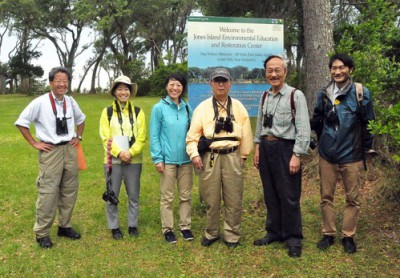OCEAN — One normally thinks of all of Japan as a noisy, bustling place, home to some of the world’s most populous and crowded cities, including Tokyo and Yokohama.
But according to the president of the island nation’s largest conservation group, the Japan Ecosystem Conservation Society, much of the country – its mountainous forests – is virtually silent, at least if you’re listening for birds.
Supporter Spotlight

Hobun Ikeya, who founded the 30,000-member society more than 30 years ago, was one of six of its 100 staff members and administrators who were in Carteret and Onslow counties Thursday and Friday of last week, visiting with counterparts at the N.C. Coastal Federation and touring some of its projects.
The goal was to learn about what the highly-successful federation does and how it does it. While here, they also visited the federation’s living shoreline project along Jones Island in Hammocks Beach State Park and the its 6,000-acre wetlands restoration project in eastern Carteret County. They also visited the National Oceanic and Atmospheric Administration’s Beaufort lab and the Duke University Marine Laboratory on Pivers Island.
During a lunch break on the two-day tour, Ikeya talked, through interpreter Ken Yoshia, the society’s executive director, about how different Japan is from the perception of many who haven’t been there.
Mountains make up about 80 percent of Japan, with many of them covered by forests, Ikeya said. But don’t think of them as national parks, like those preserved in the United States.
“It’s mostly tree farms,” Ikeya said.
Supporter Spotlight
After the World War II, Ikeya said, most of the natural forests were cut down and replanted with cedar and a few other species deemed essential for industry, including the paper industry. The practice was so widespread, he said, that the faux forests rarely serve as good habitat for birds.
As a result, when you’re in those trees, “you cannot hear much (bird) song,” Ikeya said. “It’s literally like silent spring.”
Ikeya was referring, of course, to Rachel Carson’s seminal 1962 U.S. book, which many credit with launching the environmental movement in the United States.
As Ikeya and the other members of his group talked during lunch at federation’s office in Ocean, Todd Miller showed the group a photo of pelicans on Beacon Island, an eroding nesting site in Pamlico Sound that the federation has helped by building living shorelines made of oyster shells and marsh grass.
Still, he pointed out, there are only six major real pelican nesting areas in North Carolina. But the site of the picture of the pelicans – the Japanese indicated they’d never seen one live – drew oohs and aahs from the group.
A photo of a painted bunting, the astoundingly colorful bird that frequents Hammocks Beach State Park – drew a similar response. The group hadn’t seen one during their visit to the park.

The bird situation is important in Japan, not only because the avian species serve as indicators of ecosystem health, but also because the Japanese have traditionally revered birds, Yoshia said.
Ikeya said a visitor to Tokyo, where the society has its headquarters, would often be hard-pressed to see a single bird. And in response to a question, he noted that the white ibis was driven into at least unofficial extinction in the country a few years back, and the white stork, the country’s most sacred bird, has almost disappeared.
To highlight those problems, the society has produced a beautiful towel, with a drawing of both birds soaring in front of Mt. Fuji, another revered national symbol.
“We want to show that (the national government) failed, even to protect our beautiful birds, and that we can’t make another mistake like this,” Ikeya said.
One of the society’s major goals, he said, is to preserve what remains of the country’s remaining natural habitat and to use birds from other countries to gradually bring back those species.
None of this will be easy, Ikeya said, largely because the focus of Japan’s government has long been on economic growth, to the exclusion of efforts to preserve natural habitat. That’s been especially true since the beginning of the 1990s, when the former economic powerhouse entered a long period of economic stagnation. But, he added, it’s really been more-or-less true since the country “opened up” to the west 100 or so years ago.
“The government since then has concentrated on modernizing society and the economics and the political system, but has neglected the traditional Japanese values of maintaining our natural resources,” he said. “That has fundamentally continued through today. But we are trying to change it.”
The country’s fisheries resources have been devastated by unsustainable harvests, Ikeya said, in part because government has often encouraged the watermen to “harvest as much as possible, as fast as possible.”
Projects such as the federation’s efforts to encourage North Carolina residents to use living shorelines instead of seawalls along privately-owned waterfronts, are not likely to gain any traction in Japan until a major philosophical change takes hold, he said.
“The Japanese people in general think environmental projects should be done by the government,” Ikeya said through Yoshia. “The individual property owner does not think he has anything to do with it, unfortunately. It’s totally different than what we are seeing here.”
Still, the group thinks it’s making slow headway. For example, there has long been a government policy to straighten rivers and channelize them with concrete to provide water and to prevent flooding. Ikeya said some government bureaucrats, at the urging of his group, now see that as a bad thing. Efforts are being made to restore some rivers to their natural “meandering” state, he said.
“They are gradually accepting the concept,” Ikeya said. “But that is a small achievement and we have many major challenges.”
The staffers who talked Friday were well-versed in the issues and seemed well-equipped to tackle them. For example, Takeshi Seki, the secretary general and manager of the Tokyo office, spoke of the need to convince government officials that better environmental laws are essential. Others noted that protecting the remaining intact ecosystems can actually lead to economic development of a different type: people want to see nature, and will pay to do so.
To that end, the group has staffers who do the field research necessary to look for and identify endangered plants and animals, and to work with the government to try to ensure that new road construction avoids, or at least mitigates, disruption or destruction of the habitat those species depend upon. The basic idea is to convince the government and the powerful corporations that “development can co-exist with nature,” if it’s done properly.
“We started as a small NGO about 30 years ago,” Ikeya said. “We believe we have to fundamentally change our way of life to protect and restore our natural environment.”
The group, he said, works not only with government bureaucrats, but also with teachers and elected officials and other NGOs to try to educate the Japanese public about the need to reverse longstanding policies that favor economic development.
“We come here (to the federation) and to other groups and areas in the United States and Europe to learn more about how we can do it,” he said. “We also try to act as an information source for the Japanese people.”
Others from the group on the trip were: Ayako Niwano, Yusuke Kumagai and Erina Kakimoto.







